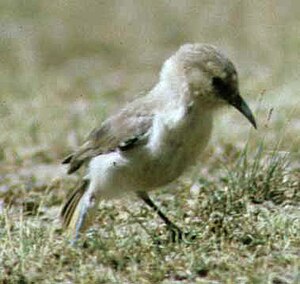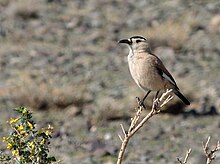Tibetan tit
| Tibetan tit | ||||||||||||
|---|---|---|---|---|---|---|---|---|---|---|---|---|

Tibetan tit ( Pseudopodoces humilis ) |
||||||||||||
| Systematics | ||||||||||||
|
||||||||||||
| Scientific name of the genus | ||||||||||||
| Pseudopodoces | ||||||||||||
| Zarudny & Loudon , 1902 | ||||||||||||
| Scientific name of the species | ||||||||||||
| Pseudopodoces humilis | ||||||||||||
| ( Hume , 1871) |


The ground tit ( Pseudopodoces humilis ), formerly referred to as Höhlenhäher is a species of bird from the family of tits (Paridae) that the Tibetan Plateau populated. For a long time it was placed among the corvids , as it is strikingly similar in appearance and way of life to the ground-dwelling jays of the genus Podoces, which are also native to Asia . Osteological , morphological and vocal characteristics, however, indicate a close relationship to the tits. This is now also supported by studies of the mitochondrial DNA . At times the species was even incorporated into the genus Parus , but now it is mostly back in the monotypic genus Pseudopodoces . The name (pseudo = false, fake) indicates the similarity or the previously assumed relationship with the genus Podoces .
description
The Tibetan tit is about the size of a starling at 19–20 cm , making it one of the largest species in the family alongside the Sultan tit . The weight is between 42.5 and 48.5 g. The species often stays upright, has long legs, appears long-feathered or fluffy and has a long, bent, black beak. The sexes do not differ. The iris is brown, the reins are blackish. The warm yellowish-beige coloration of the forehead continues on the cheeks and ear covers and is also found as a hint on the throat, sides of the chest and flanks; otherwise the underside is cream-colored. The light gray-brown color of the upper side has been flown over in sand color and is slightly lightened on the crown and rump sides. In the neck there is a light field that looks like a half-collar. The middle control feathers are dark brown, the two outer pairs whitish beige. The upper wing is overall darker than the upper side, the thumb wing black with white tips. The coverts and wings are dark brown with broad beige-brown hems. Legs and feet are black. The youth dress is similar to the adult dress , but is more yellowish-brown with a paler neck area. The rein is not black, the face is stained and the throat is streaky. The beak is straighter and shorter, the legs lighter.
voice
The Tibetan tit is not very vocal. The call is a soft, drawn Tschieep or a shorter Tschipp , which is also brought forward in further variants, rows or regular repetitions. The singing also varies the call and is introduced with a chipp before it merges into a fast, somewhat hoarse series and drops in pitch.
Distribution and existence
The main distribution area of the Tibetan tit stretches from southwestern Xinjiang eastward over the south and east of the highlands of Tibet to Ningxia and Gansu as well as southward into the south and south-east of Tibet , north-east Yunnan and western Sichuan . It is also found in southeast Ladakh , northern Nepal and Sikkim .
The species is not threatened and in some regions it is quite common. It occurs only sparsely in Ladakh. Possibly she is to be classified here as a multiplication guest.
Way of life
The altitude distribution of the Tibetan tit is between 3100 and 5500 m. Sometimes it can only be found from heights of over 4000 m. It inhabits treeless, steppe-like landscapes such as grassy plains and rocky hills with scattered shrubbery above the tree line. They are often found in yak pastures and near human settlements or monasteries. Little is known about diet. Presumably, the food consists of small insects and their larvae and is searched for on the ground. The species moves with long jumps and pokes with its beak in soft earth, in turf, yak dung and cadavers. The flight seems awkwardly fluttering and mostly only leads flat above the ground for short distances. She tries to escape enemies by jumping. She regularly associated with pikas .
The breeding season is between April and July. Two investigations showed that helpers participate in around a quarter of the broods. Most of these are (one, more rarely two) males, probably from previous broods of the respective parents. Often there is apparently also foreign copulation and paternity both outside of the group and between one of the partners of the breeding pair and a helper. Sometimes females also pass their eggs to other couples ( intraspecific brood parasitism ).
The nest consists mainly of moss, dry plant fibers and animal hair. It is built in deep holes in the ground or up to 2 m long tubes in soft soil, gravelly or rocky walls. Some of them are dug themselves and lead to a 20–40 cm deep, round chamber. Outside the breeding season, they are also laid out as sleeping places. Allegedly, burrows are also used by whistle hares. The clutch consists of 4-9 eggs that are incubated for 14-16 days. The nestling period is between 18 and 20 days. Even after they have fledged, the boys sometimes still beg for food. In a high percentage of broods (92%) at least one young was raised successfully.
literature
- Andrew Gosler, Peter Clement , Eduardo de Juana: Ground Tit ( Pseudopodoces humilis. ) (2014), In: J. del Hoyo, A. Elliott, J. Sargatal, AD Christie, E. de Juana (eds.): Handbook of the Birds of the World Alive. Lynx Edicions, Barcelona 2014.
Web links
- Photos of Pseudopodoces humilis in the Oriental Bird Club image database , accessed on January 27, 2016
- xeno-canto: Sound recordings - Ground Tit ( Pseudopodoces humilis )
- Pseudopodoces humilis in the endangered Red List species the IUCN 2012. Posted by: BirdLife International, 2012. Accessed October 29, 2014.